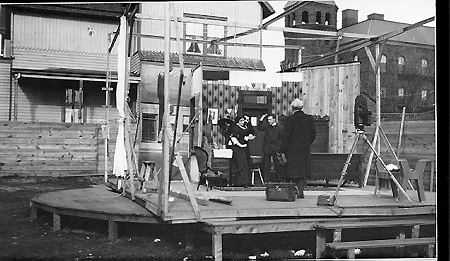 Volume I: Narrative History
Volume I: Narrative History Volume I: Narrative History
Volume I: Narrative History

An outdoor studio set, circa 1912. A caption on the original photo identified, left to right: Marguerite Snow, William Russell, and William Garwood.
Director Lucius Henderson has his back to the camera. Courtesy Robert S. Birchard (X-260)
Edwin Thanhouser and his studio entered the year 1912 with enthusiasm. The preceding year had seen record profits, and critical reviews of Thanhouser Company films had progressed from mixed to a high degree of acclaim. No longer was the Thanhouser entry a tentative one in the motion picture market, it was part of the very foundation of the industry. The coming year would be one of change, expansion, and transition for the company, including filming in locations other than the New Rochelle area, a change of the guard in management, increased production, and dissention in the ranks of the Independents.
In early 1912 directors Lucius J. Henderson and George O. Nichols were set to create many films of merit, while Lloyd F. Lonergan, constituting the one-man scenario department, was working on a dozen ideas all at once. The most important stock players in the studio included Mignon Anderson, Marguerite Snow, and Florence LaBadie on the distaff side, balanced by James Cruze, William Russell, Harry Benham, and Justus D. Barnes, plus several dozen others who played supporting roles. Right out in front was little Marie Eline, the Thanhouser Kid, who continued to generate reams of publicity, and infant Helen Badgley, the Thanhouser Kidlet, who was just beginning to draw critical notice for her precocious actions before the camera. Turning the crank were Carl Louis Gregory and Alfred H. Moses, Jr., joined by several others, who by the end of the year included Emmett A. Williams and his brother Lawrence, A.H. Davis, Lawrence Fowler, and actor-cameraman Francis Newburgh.
From 1909 through the end of 1911 Thanhouser players were a stay-at-home bunch. While a month-long sortie was taken to film The Last of the Mohicans in the Adirondacks in 1911, and while Thanhouserites went to Niagara Falls the same year, by and large the films were produced in and around New Rochelle, with occasional travels to points not more than an hour or so away, with Coney Island and Manhattan being favorite "distant" locations. This was to change in 1912, and by February, a rather pretentious advertisement Note would state that three - count them, three - companies were "producing for the glory of Thanhouser." The Northern Company was headquartered at Niagara Falls, the Home Company was nestled in New Rochelle, and the Southern Company was busy in St. Augustine, Florida producing H. Rider Haggard's Jess for the screen.
Copyright © 1995 Q. David Bowers. All Rights Reserved.